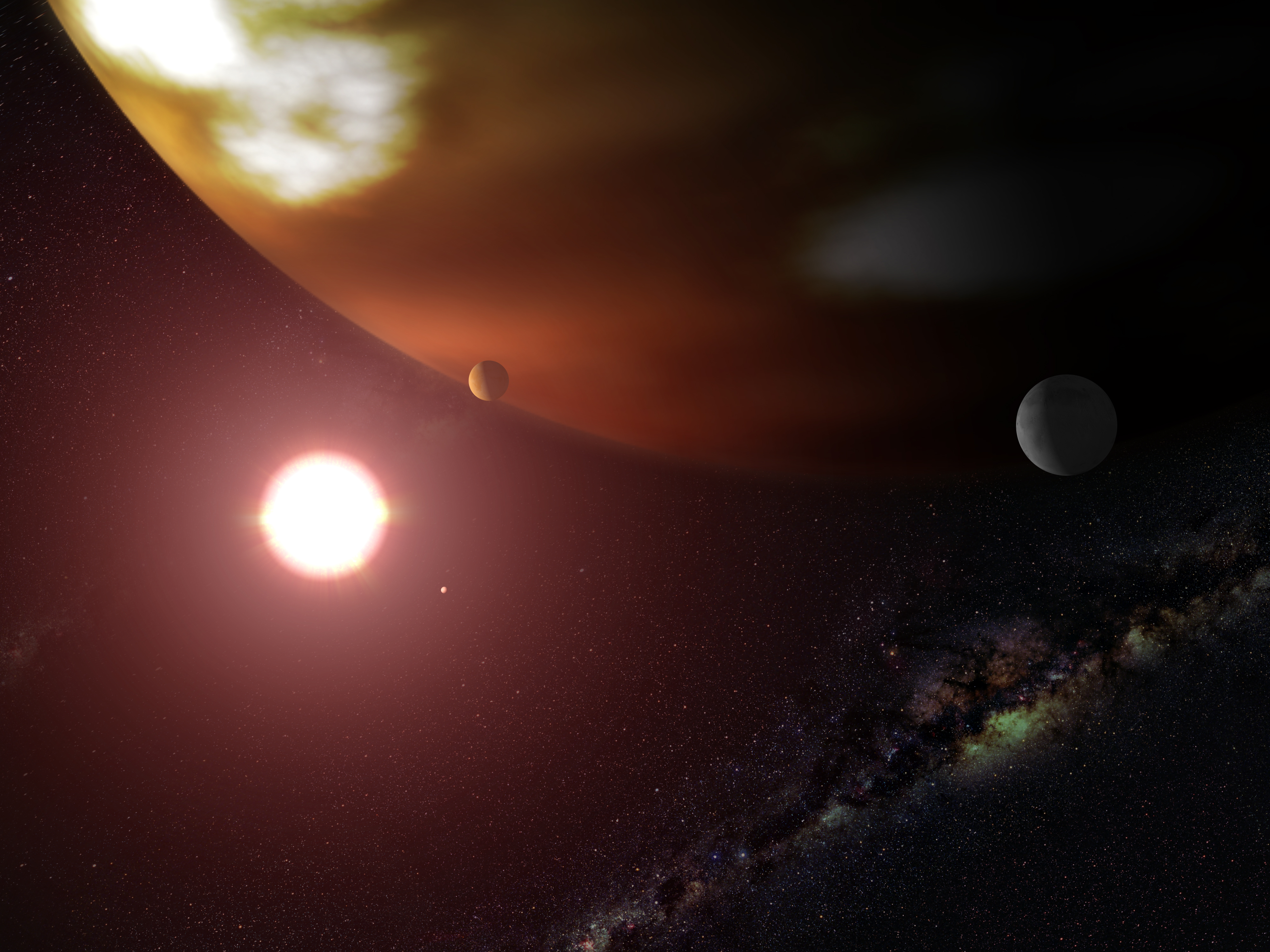- Gliese 876 b
Planetbox begin
name=Gliese 876 bPlanetbox image

caption = An artist's impression of Gliese 876b.Planetbox star
star =Gliese 876
constell = Aquarius
RA = RA|22|53|16.73
DEC = DEC|−14|15|49.3
dist_ly = 15.3
dist_pc = 4.7
class = M3.5VPlanetbox orbit
semimajor=0.208 ± 0.012
eccentricity=0.029 ± 0.005cite journal| author=G. Laughlin "et al." | journal=Astrophysical Journal | issue=622| page=1182-1190 |year=2005]
period=60.940 ± 0.013
ang_dist=44.032
long_peri=175.7 ± 6.0
t_peri=2,452,460.3 ± 1.0
semi-amp=212.6 ± 0.76
semimajor_gigameter =
periastron = 0.201968
periastron_gigameter =
apastron = 0.214
apastron_gigameter =
period_year =0.1668446
period_megasecond = Planetbox character
mass=>1.93-2.4 [G. Laughlin (2005) m sin i = 1.935, i = 84±6 degrees per Benedict, G. F. "et al." ApJL, 581, L115 (2002)]
radius=
density=
gravity=
temperature=
mass_earth = 613.354
gravity_earth =
insolation =
insolation_earth =
radius_megameter =
mass_wekagram =
radius_earth =Planetbox discovery
discovery_date =23 June 1998
discoverers = Marcy "et al."
discovery_method =Radial velocity
discovery_site = California and
Carnegie Planet Search
flag|United States
discovery_status = PublishedPlanetbox catalog
names=GJ 876 b,G 156-57B,8pc 212.69B Planetbox reference
star=Gliese+876
planet=bGliese 876b is an
extrasolar planet orbit ing thered dwarf star Gliese 876 every 60.940day s. Discovered in June 1998, Gliese 876b was the first planet to be discovered orbiting a red dwarf. It is the outermost known planet in itsplanetary system .Discovery
Orbit and mass
Gliese 876b is in a 2:1
orbital resonance with the inner planetGliese 876c , [cite journal|url=http://cdsads.u-strasbg.fr/cgi-bin/nph-bib_query?2001ApJ...556..296M&db_key=AST&nosetcookie=1|author=Marcy, G. et al.|title=A Pair of Resonant Planets Orbiting GJ 876|journal=The Astrophysical Journal |volume=556|issue=1|pages=296 – 301|year=2001] which leads to strong gravitational interactions between the two planets. [cite journal|url=http://adsabs.harvard.edu/abs/2001ApJ...558..392R|author=Rivera, E., Lissauer, J.|title=Dynamical Models of the Resonant Pair of Planets Orbiting the Star GJ 876|journal=The Astrophysical Journal |volume=558|issue=1|pages=392 – 402|year=2001] As a result, theorbital elements of the planet change fairly rapidly as the orbits precess. [cite journal|url=http://www.journals.uchicago.edu/doi/abs/10.1086/504701|author=Butler, R. et al.|title=Catalog of Nearby Exoplanets|journal=The Astrophysical Journal |volume=646|pages=505 – 522|year=2006 ( [http://exoplanets.org/planets.shtml web version] )] The planet's orbit has a low eccentricity, similar to the planets in oursolar system . Thesemimajor axis of the orbit is only 0.208 AU, less than that of Mercury in our solar system. However Gliese 876 is such a faint star that this puts it in the outer part of thehabitable zone . [cite journal|url=http://cdsads.u-strasbg.fr/cgi-bin/nph-bib_query?2005ApJ...622.1091J&db_key=AST&nosetcookie=1|author=Jones, B. et al.|title=Prospects for Habitable "Earths" in Known Exoplanetary Systems|journal=The Astrophysical Journal |volume=622|issue=2|pages=1091 – 1101|year=2005]A limitation of the radial velocity method used to detect Gliese 876b is that only a lower limit on the planet's
mass can be obtained. This lower limit is around 1.93 times the mass ofJupiter . Thetrue mass depends on theinclination of the orbit, which in general is unknown. In the case of a resonant system like Gliese 876, gravitational interactions between the planets can be used to find the true masses: the best fit to the radial velocity data is for an inclination of around 50° to the plane of the sky. [cite journal|url=http://cdsads.u-strasbg.fr/cgi-bin/nph-bib_query?2005ApJ...634..625R&db_key=AST&nosetcookie=1|author=Rivera, E. et al.|title=A ~7.5 M⊕ Planet Orbiting the Nearby Star, GJ 876|journal=The Astrophysical Journal |volume=634|issue=1|pages=625 – 640|year=2005] If this is the case, the true mass is approximately 30% greater than this lower limit, at around 2.5 Jupiter masses. On the other hand, astrometric measurements suggest the orbital inclination is around 84°, which suggests the mass is only slightly greater than the lower limit. [cite journal|url=http://cdsads.u-strasbg.fr/cgi-bin/nph-bib_query?2002ApJ...581L.115B&db_key=AST&nosetcookie=1|author=Benedict, G. et al.|title=A mass for the extrasolar planet Gliese 876b determined from Hubble Space Telescope fine guidance sensor 3 astrometry and high-precision radial velocities|journal=The Astrophysical Journal |volume=581|issue=2|pages=L115 – L118|year=2002]Physical characteristics
Given the planet's high mass, it is likely that Gliese 876b is a
gas giant with nosolid surface. Since the planet has only been detected indirectly through its gravitational effects on the star, properties such as itsradius , composition andtemperature are unknown. Assuming a composition similar toJupiter and an environment close tochemical equilibrium , it is predicted that the atmosphere of Gliese 876b iscloud less, though cooler regions of the planet may be able to formwater clouds. [cite journal|url=http://adsabs.harvard.edu/abs/2003ApJ...588.1121S|author=Sudarsky, D. et al.|title=Theoretical Spectra and Atmospheres of Extrasolar Giant Planets|journal=The Astrophysical Journal |volume=588|issue=2|pages=1121 – 1148|year=2003]Gliese 876b lies within the habitable zone of Gliese 876 as defined by the ability of an
Earth -mass planet to retainliquid water at its surface. While the prospects forlife on a gas giant are unknown, large moons may be able to support a habitable environment. Models of tidal interactions between a hypothetical moon, the planet and the star suggest that large moons should be able to survive in orbit around Gliese 876b for the lifetime of the system. [cite journal|url=http://adsabs.harvard.edu/abs/2002ApJ...575.1087B|author=Barnes, J., O'Brien, D.|title=Stability of Satellites around Close-in Extrasolar Giant Planets|journal=The Astrophysical Journal |volume=575|issue=2|pages=1087 – 1093|year=2002 (paper incorrectly refers to Gliese 876b as GJ876c)] On the other hand, it is unclear whether such moons could form in the first place. [cite journal|url=http://www.nature.com/nature/journal/v441/n7095/abs/nature04860.html|author=Canup, R., Ward, W.|title=A common mass scaling for satellite systems of gaseous planets|journal=Nature|volume=441|year=2006|pages=834 – 839]See also
*
Appearance of extrasolar planets References
External links
*
*
*
* [http://www.extrasolar.net/planettour.asp?StarCatID=normal&PlanetID=2 www.extrasolar.net]
Wikimedia Foundation. 2010.
